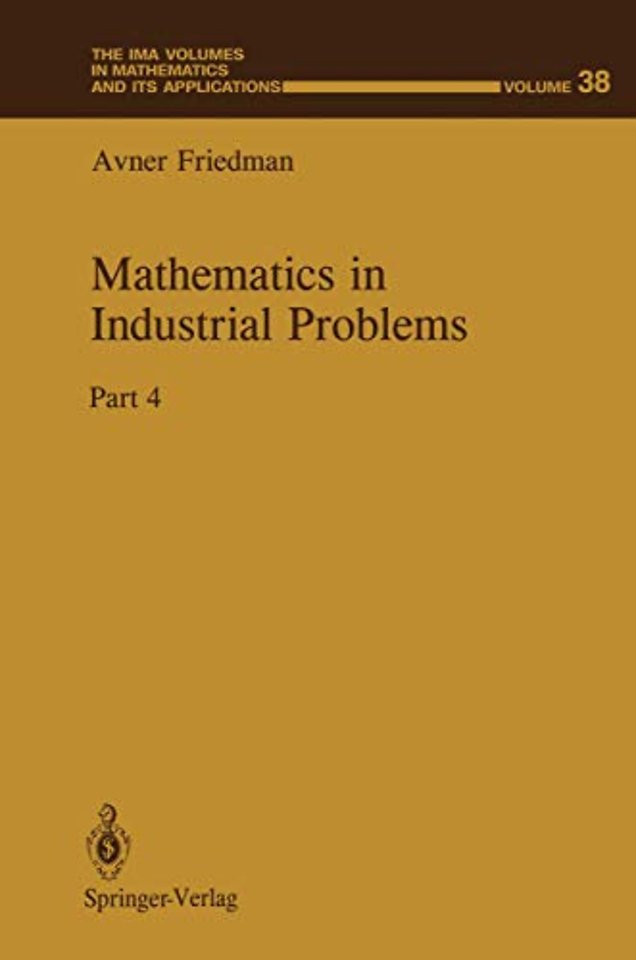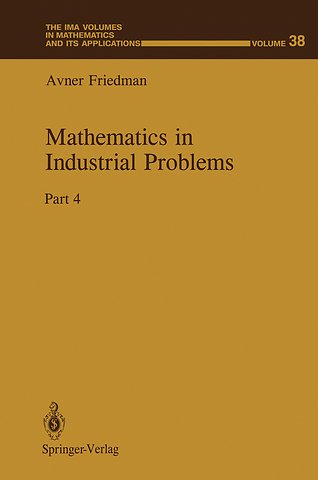1 Real-world free boundary problems.- 1.1 Hypersonic flow.- 1.2 Problems with free boundaries close to fixed boundaries.- 1.3 Free boundary problems in superconductors.- 1.4 Elastic contact.- 1.5 Partial solution.- 1.6 References.- 2 Terminally attached polymer chains.- 2.1 Experiments and the MWC model.- 2.2 The SCF theory.- 2.3 Numerical results.- 2.4 Mathematical problems.- 2.5 References.- 3 Orientation of colloidal magnetically switchable particles.- 3.1 Ferrohydrodynamics.- 3.2 A statistical mechanics approach.- 3.3 References.- 4 Information, probability and learning from examples.- 4.1 Learning from examples.- 4.2 Simple geometric examples.- 4.3 The Vapnik and Chervonenkis theory.- 4.4 References.- 5 An augmented drift-diffusion formulation in semiconductor devices.- 5.1 Semiconductor device modeling.- 5.2 The augmented drift-diffusion model.- 5.3 Mathematical issues.- 5.4 Partial solution.- 5.5 References.- 6 Analytical and heuristic modeling of distributed algorithms.- 6.1 Examples and terminology.- 6.2 Analytic results.- 6.3 Markov mode for search tree.- 6.4 Search with multiprocessor.- 6.5 References.- 7 Modeling catalytic converter performance.- 7.1 Chemical reactions.- 7.2 The differential equations.- 7.3 Numerical approach.- 7.4 Control problems.- 7.5 References.- 8 A model for titanium silicide film growth.- 8.1 Description of the process.- 8.2 A model with interfaces.- 8.3 A two-dimensional model.- 8.4 References.- 9 A three-state model for gel electrophoresis.- 9.1 Polymer reptation and the repton model.- 9.2 A biased repton model.- 9.3 Mapping into a discrete pseudospin model.- 9.4 Mean field approximation.- 9.5 Open problems.- 9.6 References.- 10 A limited coalescence problem.- 10.1 The model.- 10.2 Asymptotic distribution.- 10.3 The Monte Carlo method.- 10.4 Mathematical results.- 10.5 References.- 11 High field semiconductor equations.- 11.1 Motivation.- 11.2 Scaling.- 11.3 Moderate force.- 11.4 Strong force.- 11.5 The semiconductor case.- 11.6 Open problems.- 11.7 References.- 12 Structured singular values and invariant theory.- 12.1 FDLTI systems.- 12.2 Feedback under parametric uncertainty.- 12.3 Structured singular value.- 12.4 A new approach.- 12.5 Open problems.- 12.6 References.- 13 Signal design with an amplitude constraint.- 13.1 Lp/Lq signal design.- 13.2 Necessary optimality condition.- 13.3 The fixed-point problem.- 13.4 Open problems.- 13.5 References.- 14 Head-disk interface in magnetic storage device.- 14.1 Modified Reynolds equation.- 14.2 Free molecular flow.- 14.3 The limiting process as h?0.- 14.4 References.- 15 Parameter identification in a reaction diffusion model.- 15.1 The direct problem.- 15.2 The inverse problem.- 15.3 Modification of the model.- 15.4 A related problem.- 15.5 Existence and uniqueness.- 15.6 References.- 16 Linear analysis of megastructures.- 16.1 The three bar truss.- 16.2 The hypercircle method.- 16.3 References.- 17 Aerodynamic design with cfd.- 17.1 Vehicle drag.- 17.2 Governing equations.- 17.3 Simplifications.- 17.4 Research areas.- 17.5 References.- 18 Experimental design and quality loss function.- 18.1 Experimental design.- 18.2 Motivation.- 18.3 Sampling.- 18.4 The quality loss function.- 18.5 References.- 19 Numerical simulations for industrial chemical research.- 19.1 Computational approach to chemical research.- 19.2 Theoretical concepts.- 19.3 Requirements for atomistic computations.- 19.4 References.- 20 An adaptive feedforward approach to robot control.- 20.1 Mathematical model.- 20.2 Nonlinear feedforward.- 20.3 Path planning.- 20.4 Mathematical issues.- 20.5 References.- 21 Solutions to problems from part 3.- 21.1 References.

